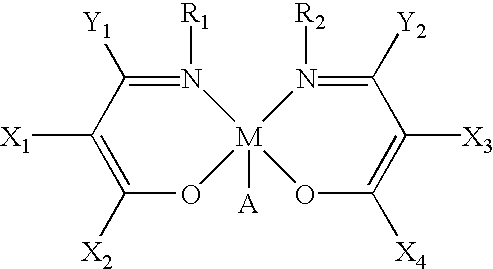Main-group metal-based asymmetric catalysts and applications thereof
- Summary
- Abstract
- Description
- Claims
- Application Information
AI Technical Summary
Benefits of technology
Problems solved by technology
Method used
Image
Examples
example 1
This example describes the enantioselective addition of HCN to imines (the Strecker reaction) catalyzed by the chiral (salen)Al(III) complex 8. In the first successful application of main-group (salen)metal complexes in asymmetric catalysis, excellent enantioselectivities are achieved in the hydrocyanation of a range of aryl substituted imines. The applicability of this methodology to the practical synthesis of enantiomerically pure amino acid derivatives is illustrated in a synthesis of enantiopure (S)-2-naphthylglycine methyl ester on a 6 mmol scale.
The addition of cyanide to imines (the Strecker reaction)1 constitutes one of the most direct and viable strategies for the asymmetric synthesis of α-amino acid derivatives. Significant progress has been made in the development of stereoselective versions of this reaction using imines bearing covalently attached chiral auxiliaries.2 However, despite the obvious practical potential of an enantioselective catalytic version of the Strecke...
example 2
Preparation of (R,R)-1,2-Diphenyl-1,2-bis(3-tert-butylsalicylideamino)ethane
A solution of 360.5 mg (2.0 mmol) of 3-tert-butylsalicylaldehyde in 3 ml of EtOH was added dropwise to a solution of 212.3 mg (1.0 mmol) of (R,R)-1,2-diamino-1,2-diphenylethane in 5 ml of EtOH. The reaction mixture was heated to reflux for 1 h and water (5 ml) was added. The oil that separated solidified upon standing. Recrystallization from MeOH / H2O gave 485.8 mg (91%) of yellow powder, mp 73-74° C. 1H NMR (CDCl3) δ 1.42 (s, 18H, CH3), 4.72 (s, 2H, CHN═C), 6.67-7.27 (m, 16H, ArH), 8.35 (s, 2H, CH═N), 13.79 (s, 2H, ArOH) ppm; 13C NMR (CDCl3) δ 29.3, 34.8, 80.1, 117.8, 118.5, 127.5, 128.0, 128.3, 129.6, 130.1, 137.1, 139.5, 160.2, 166.8 ppm. Anal. Calcd. for C36H40N2O2. C, 81.17; H, 7.57; N, 5.26. Found: C, 81.17; H, 7.60; N, 5.25.
example 3
Preparation of (R,R)-1,2-Diphenyl-1,2-bis(3-diphenylmethylsilylsalicylideamino)ethane.
3-(Diphenylmethylsilyl)salicylaldehyde was prepared from 2-bromophenol in 5 steps according to established procedures. A solution of 348.3 mg (1.09 mmol) of 3-(diphenylmethylsilyl)salicylaldehyde and 116.0 mg (0.546 mmol) of (R,R)-1,2-diamino-1,2-diphenylethane in 5 ml of ethanol was heated to reflux for 0.5 h. A bright yellow oil separated from the solution and it solidified upon standing. The mixture was filtered and the yellow solid was washed with 2×5 ml ethanol. The isolated yield of product pure by 1H NMR analysis was 416 mg (97%). 1H NMR (CDCl3) δ 0.95 (s, 3H), 4.68 (s, 2H), 6.72-7.55 (m, 36 H, ArH), 8.37 (s, 2H), 13.34 (s, 2H) ppm.
PUM
| Property | Measurement | Unit |
|---|---|---|
| Fraction | aaaaa | aaaaa |
| Fraction | aaaaa | aaaaa |
| Fraction | aaaaa | aaaaa |
Abstract
Description
Claims
Application Information
 Login to View More
Login to View More - R&D
- Intellectual Property
- Life Sciences
- Materials
- Tech Scout
- Unparalleled Data Quality
- Higher Quality Content
- 60% Fewer Hallucinations
Browse by: Latest US Patents, China's latest patents, Technical Efficacy Thesaurus, Application Domain, Technology Topic, Popular Technical Reports.
© 2025 PatSnap. All rights reserved.Legal|Privacy policy|Modern Slavery Act Transparency Statement|Sitemap|About US| Contact US: help@patsnap.com



